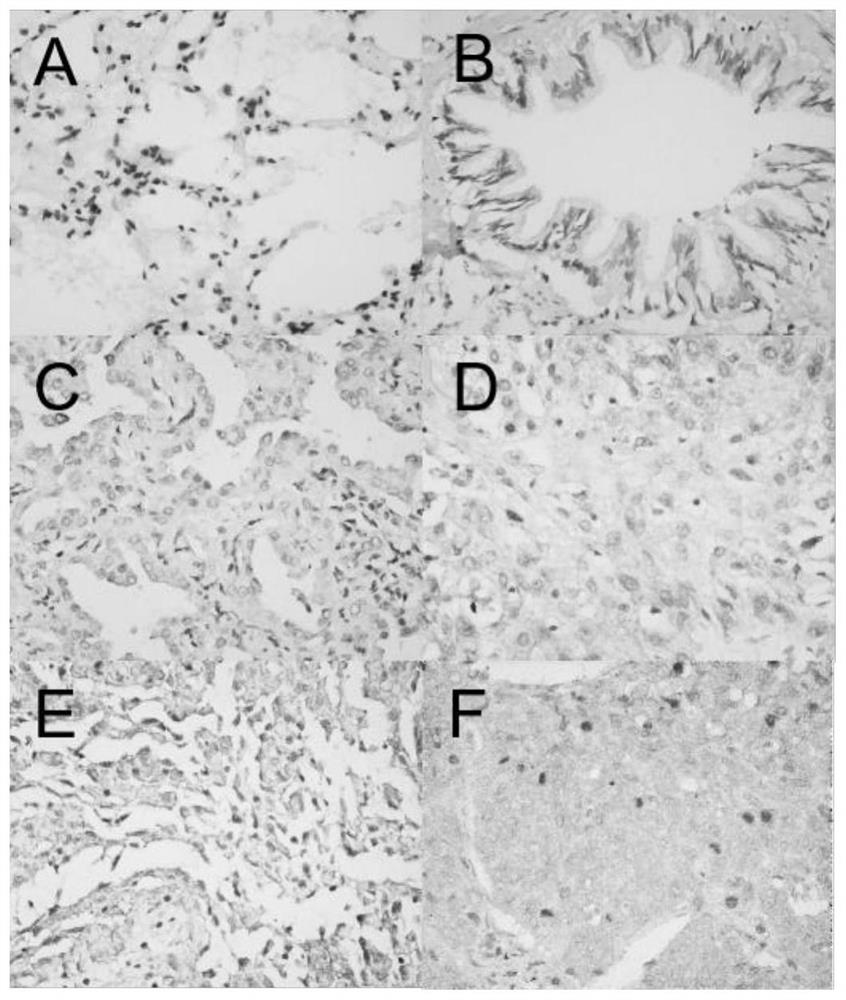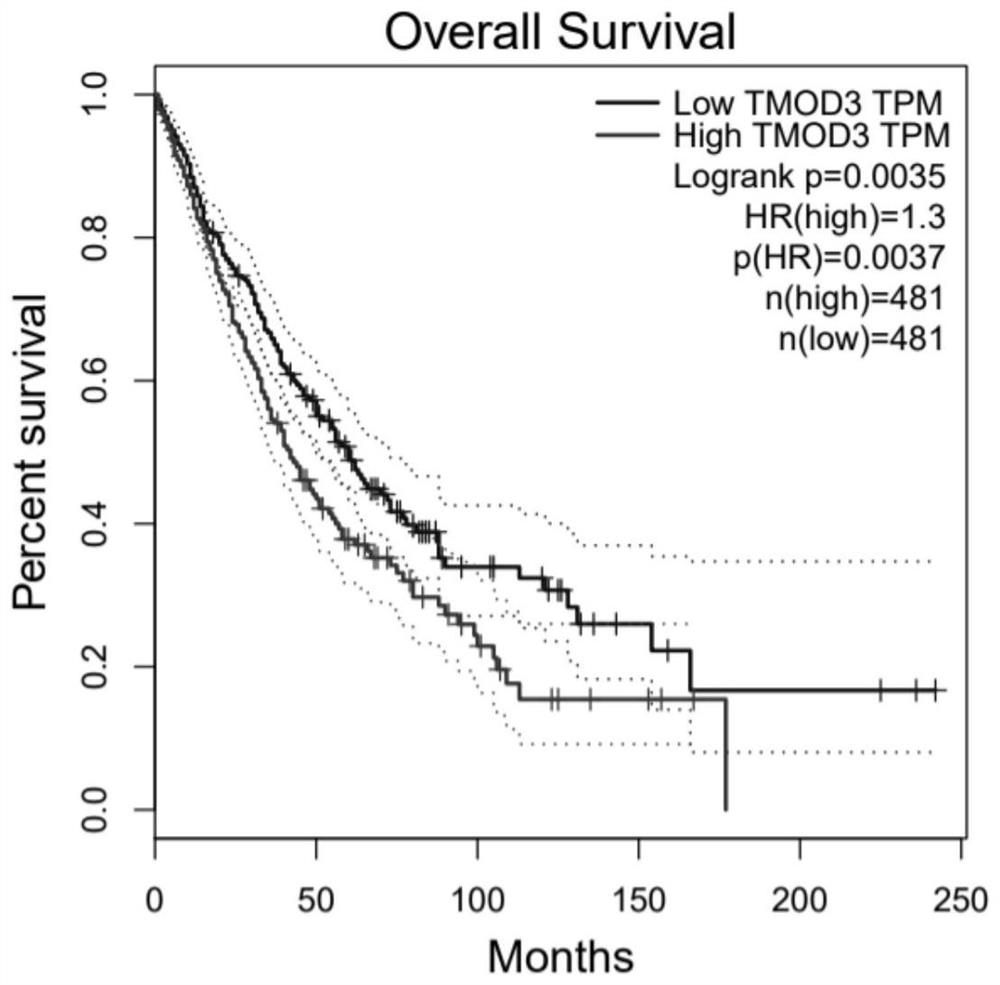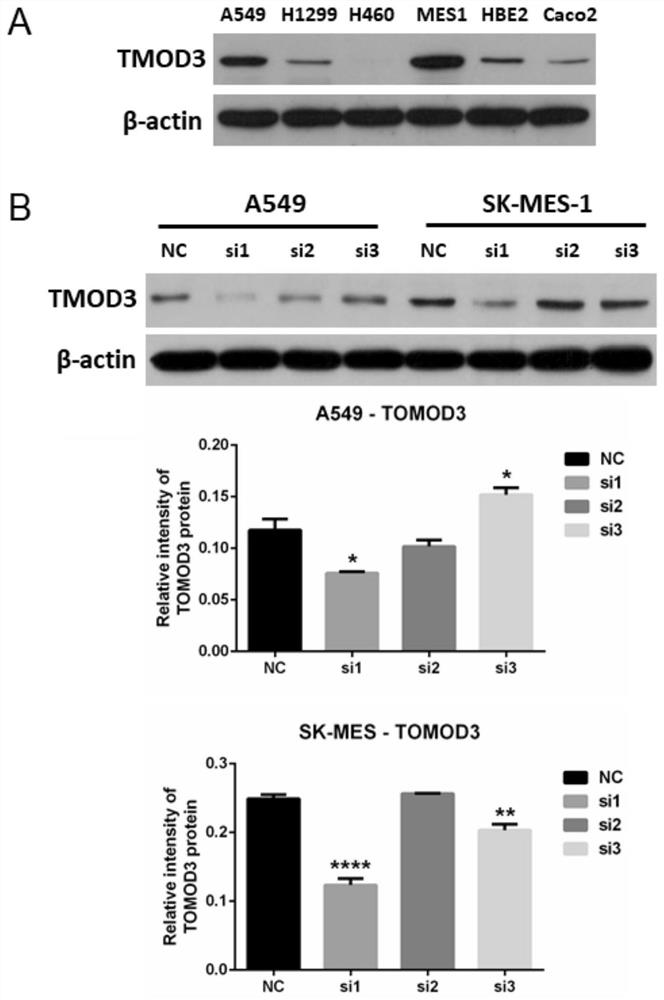Application of TMOD3 and/or ADSL in non-small cell carcinoma
A technology in non-small cell lung cancer and samples, applied in the field of disease treatment, can solve the problems of unclear molecular mechanism of non-small cell lung cancer cell regulation, unclear relationship between non-small cell lung cancer, etc., and achieve the effect of enhancing malignant progression
- Summary
- Abstract
- Description
- Claims
- Application Information
AI Technical Summary
Problems solved by technology
Method used
Image
Examples
Embodiment 1
[0047] Example 1 Expression of TMOD3 in clinical samples of non-small cell lung cancer
[0048] From 2014 to 2016, 118 patients with non-small cell lung cancer (NSCLC) who underwent surgical resection and were pathologically diagnosed in the First Affiliated Hospital of China Medical University were selected. All 118 patients who participated in this pathological correlation analysis did not receive radiotherapy and chemotherapy before surgery. Male patients (N=82) and female patients (N=36), aged between 37 and 77 years. According to the 8th edition of the International Union Against Cancer (UICC) TNM staging system for lung cancer, patients with stage I-IIa (N=61 cases) and patients with stage IIb-IV (N=57 cases). According to the WHO classification system, squamous cell carcinoma (N=58 cases), adenocarcinoma (N=60 cases), moderately to well differentiated (N=67 cases), and poorly differentiated (N=51 cases). Tumor size classification, less than or equal to 3cm cases (N=65...
Embodiment 2
[0053] Example 2 The effect of TMOD3 on the malignant progression phenotype of non-small cell lung cancer
[0054] 1. Expression analysis and interference screening of TMOD3 in non-small cell lung cancer cells
[0055] Non-small cell lung cancer cell lines A549, H1299, H460 and SK-MES-1, normal lung epithelial cell HEB2, and control cell Caco2 were cultured in 25T culture flasks, and then recovered and passaged for 2 generations until the cells were in a stable state.
[0056] Western blot was used to analyze the expression of TMOD3 protein in non-small cell lung cancer cell lines A549, H1299, H460 and SK-MES-1 cells, and HBE2 and Caco2 cells were used as controls, and the experiment was repeated three times. The results showed that the lung adenocarcinoma cell line A549 and the lung squamous cell carcinoma cell line SK-MES-1 showed high expression of TMOD3 ( image 3 A).
[0057] In order to further explore the role of TMOD3 in non-small cell lung cancer, the inventors desi...
Embodiment 3
[0088] Example 3 To study the effect of TMOD3 on ferroptosis in non-small cell lung cancer cells
[0089] Interfering with TMOD3 in A549 and SK-MES-1 cells, and treating the cells with the ferroptosis activator Erastin, the MTT detection kit (Abnova, KA0814) combined with a microplate reader (Biotek microplate reader Epoch, USA) was used for analysis. The results showed that, Erastin alone can inhibit the activity of non-small cell lung cancer cells; and compared with the control interference treatment, interference with TMOD3 can further enhance the inhibitory effect of Erastin on the activity of non-small cell lung cancer cells ( Figure 7 A and B).
[0090] Interfering with TMOD3 in A549 and SK-MES-1 cells, the iron detection kit analysis showed that compared with the control interference treatment, interference with TMOD3 could significantly enhance the content of iron ions in non-small cell lung cancer cells ( Figure 7 C and D).
[0091] The above experiments show that...
PUM
 Login to View More
Login to View More Abstract
Description
Claims
Application Information
 Login to View More
Login to View More - R&D
- Intellectual Property
- Life Sciences
- Materials
- Tech Scout
- Unparalleled Data Quality
- Higher Quality Content
- 60% Fewer Hallucinations
Browse by: Latest US Patents, China's latest patents, Technical Efficacy Thesaurus, Application Domain, Technology Topic, Popular Technical Reports.
© 2025 PatSnap. All rights reserved.Legal|Privacy policy|Modern Slavery Act Transparency Statement|Sitemap|About US| Contact US: help@patsnap.com



